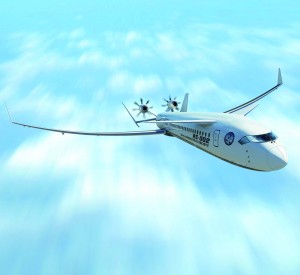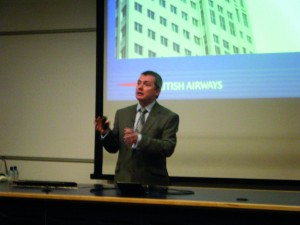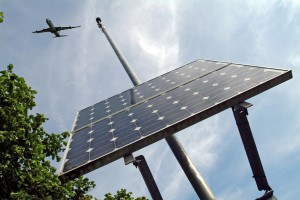With the aviation industry now moving out of survival mode, the environment is now firmly back on the agenda for decision makers. TIM ROBINSON reports from the first Imperial College Aviation Forum held on 6 January.
This is a full article published in Aerospace International: February 2011Though the environment has never been off the agenda for aviation, it is fair to argue that the recession, ash clouds and, most recently, severe winter weather, have meant long-term sustainable aviation efforts have received a lower priority as airlines struggled from one crisis to the next. However, with growth now back on and a general mood of cautious optimism returning in the industry, the environment is set to move back to top of the agenda. Perhaps a good indicator of this was Imperial College’s first Green Aviation Forum which, as well as poster sessions describing the university’s latest research on aviation technology, also featured top-level speakers from British Airways, Rolls-Royce, Eurocontrol, Airbus and BAA among others. Let us take a look at some of the highlights.
Aerospace International Contents - February 2011
News Roundup - p4
Fresh Greens - p12
Imperial College Green Aviation Forum
Plane Speaking - p14
Interview with Charles Champion Airbus executive vp engineering
Defending coastlines p 18
Maritime air patrol requirements
Awakening dragon - p22
China’s aerospace industry gears up
Ice warriors- p24
Technical focus on aircraft de-icing
Virtual voices- p28
Voice communication simulation training
Picking up the pieces - p32
UK industrial partner co-operation
The last word - p34
Keith Hayward compares UK and French industrial strategy
Airlines have ‘woken up’
First speaker was British Airways ceo Willie Walsh. He noted that BA one of the first airlines to publicly set environmental targets back in the 1990s. Furthermore, he argued that, while the price factor was important, the environment was now high (and getting higher) on consumers’ agenda. So much so, that he maintains that, in the past four years “globally airlines have woken up to this” and there was wide acceptance from carriers all around the world. While he admitted that the industry had previously made a ‘mistake’ by downplaying its share of emissions as ‘only’ 2% he noted that: “Few global industries (and perhaps only one) are as united as aviation” on the need to change for the environment.
So what is BA doing? First, it has set itself some very challenging green targets. For 2010 it has been working on 1·5% fuel efficiency savings per annum. From 2020 it wants to achieve carbon neutral growth CNG. Indeed BA’s carbon efficiency target for 2025 is 83g CO2/per pax km (compared to Toyota Prius 89g CO2/km). While this is obviously lower if the car is full, Walsh points out the majority of car journeys involve a single occupant — unlike airliners.
Biofuels potential
BA is also getting more involved in biofuel with Walsh now excited about the prospects — saying there is “much more potential.” It will partner with US company Solena to build a biofuel plant in London to convert biomass waste to liquids in commercial quantities for the airline. Additionally, BA is also co-operating with Rolls-Royce on a three-month biofuel test programme this year. BA will supply an engine, with R-R providing a test stand to test various biofuels.
However, not all at the forum were so optimistic. One delegate pointed out that “what is holding back renewable aviation fuels is price (roughly double kerosene) not volume.” Competition, too, from other industries, should biofuels be widely accepted could see the aviation industry battling for its share. But there was hope too — with another delegate saying that, if technology was further in the future — accelerating and expanding a kerosene solution would bring the biggest near-term benefit to airlines.
Race now on for open rotor
Yet technology, too, is not standing still, with exciting developments from European airframe and engine manufacturers, as well as Clean Sky, a €1·6bn project running until 2018 into green aviation technology. Eric Dautriat, executive director, Clean Sky Joint Technology Initiative revealed that, in 2015, Clean Sky plans to flight test an open rotor demonstrator engine on an Airbus A340. This open rotor engine will be from Rolls-Royce or Safran with Clean Sky running two parallel projects for this breakthrough propulsion system. With an aggressive schedule of a flight test by 2015, the two competing projects from British and French manufacturers is intended to mitigate risk. This doubling up of research then is a clear indication of how important Europe views this technology which, as Dautriat notes, could be mature in time for Airbus’ A320 replacement.
Ric Parker, director of research & technology, Rolls-Royce, also confirmed his company’s interest in open rotor which falls into its Vision 10 (ten year) concepts. The Vision 10 engines also include Advance 3 (three-shaft) a large engine concept aimed at a 777 successor and A320/737 replacements along with an Advance 2 engine concept two shaft aimed at bizjets. On the open-rotor noise issue, Parker says: “We believe we can make an open-rotor engine 20db quieter than current A320 engines.” However, with any open-rotor engine to enter service in 2022/25, a key question may be any future (as yet unknown) noise regulations it may have to meet. That, and the huge investment (each new Trent costs about £1bn to develop) are the biggest issues in the way of open rotor.

Europe's Clean Sky Open Rotor demostrator may feed into a possible A320 replacement in the mid 2020s. (Royal Aeronautical Society/Kaktus Digital).
This open-rotor effort could mesh nicely with any future Airbus single-aisle airliner which, said Axel Krein, senior vp, Research & Technology, Airbus, could be expected in around 2025. This new clean-sheet airliner could incorporate the latest in ultra-efficient aviation technology such as laminar flow, intelligent airframes and nanotech self-healing structures, according to Krein. A green fuel cell, replacing the APU, is also part of Airbus’ vision for its next all-new project. In the meantime, however, Klein says the Airbus A320neo will deliver 15% less fuel burn to airline customers in 2016.
ATM’s role in green aviation
But it will not just be biofuels, new engines and airframes that will be needed to address the environmental challenge. David McMillan, director general, Eurocontrol, said that with European air traffic to resume 3-4% growth next year, “we are running this system pretty close to capacity.” Even in 2010, with the ash shutdown, he said, flights in Europe were up by 1%. However, despite this crowded airspace, there were opportunities for efficiency. Europe’s SESAR modernisation project, for example, is funded to the tune of €2·1bn — more than Clean Sky. Additionally, measures such as collaborative decision making can improve efficiency. After Munich Airport adopted this waiting time decreased by 25%. continuous descent approaches (CDA), too, reduce fuel burn and noise and Europe will have more than 100 CDA airports by 2013. Still, there remain challenges — even with direct routing becoming more and more available “Sometimes airlines don’t always like to fly the shortest route.” says McMillian. What needs to happen to improve efficiency, he says, is: “We have to move away from controllers controlling individual aircraft to controlling flows of aircraft in future.”
Airports playing their part
Finally, airports around the world are now working hard on facing the green challenge. Matthew Gorman, corporate responsibility & environment director, BAA confirmed that there is new pressure from passengers: “There is no reduction in flying but there is a sense of increasing consumer guilt and they now expect the aviation industry to address green issues”. Heathrow, which attracts controversy anyway due to its location, is perhaps a special case but exemplifies the environmental concerns that it faces. For example, for local residents, noise and local air quality are the two key topics — rather than long-term CO2 emissions.
Indeed, says Gorman, ground movement at LHR is the single biggest source of emissions over separate sources (arriving and departing aircraft and ground vehicles). To that end, Heathrow is now investigating reduced engine taxiing, and plug-in power on ground to reduce emissions (and noise).
Noise is still a major environmental issue at LHR and while there are ever-quieter aircraft there are more of them. Gorman also admits that noise metrics and contours are also confusing to the public and local residents and BAA is working on making these easier to grasp. The airport is also measuring the noise insulation it subsidises to homes near the airport to see how effectively it is working.
However, the perceptions of Heathrow as dirty persist. Gorman notes that “air quality in London is not just a LHR problem” and says it is in fact twice as bad in Baker Street/Marleybone. But BAA is tackling these problems — in late 2010 it launched a ‘sustainable partnership’ with 16 other companies at the airport to set shared green goals.
Conclusion
Progress, then, is swiftly accelerating. Far from doing nothing, the aviation industry has been extremely proactive and is now extremely united — a point made time and time again by speakers. This has now changed so airlines in both developed and developing worlds agree. Indeed, the shipping industry, a couple of speakers noted, will also come under similar pressure as the aviation industry as the spotlight falls on its ‘dirty’ fuels. Aerospace, in this respect, is ahead of the maritime industry. Indeed as speaker Sir Brian Hoskins, from Imperial College’s Grantham Institute on Climate Change noted, aviation is actually less than the 2% of emissions usually stated because it has only begun relatively recently compared to comparable sectors. But this share is growing fast as other industries switch to reduce their share and as aviation expands. Says Hoskins: “Whatever we do now, it will not have any effect until after 2030.”
So, while aviation can be proud of its achievements so far, the pressure is still on. This Forum, then, showed that the environment is now firmly back on top of the agenda.
The Royal Aeronautical Society will be holding the Greener by Design annual conference on 18 October 2011 - Aviation and Climate Change – exploring the the way ahead. The day will provide a broad update – Atmospheric Science, Technologies, Operations and Market based economic options, with a closing panel and discussion forum.
This is a full article published in Aerospace International: February 2011. As a member, you recieve two new Royal Aeronautical Society publications each month - find out more about membership.











[...] in this, there may be a positive aspect – high oil prices could also accelerate biofuel plans, force airlines to replace older thirstier airliners and even drive breakthrough ultra-efficient [...]